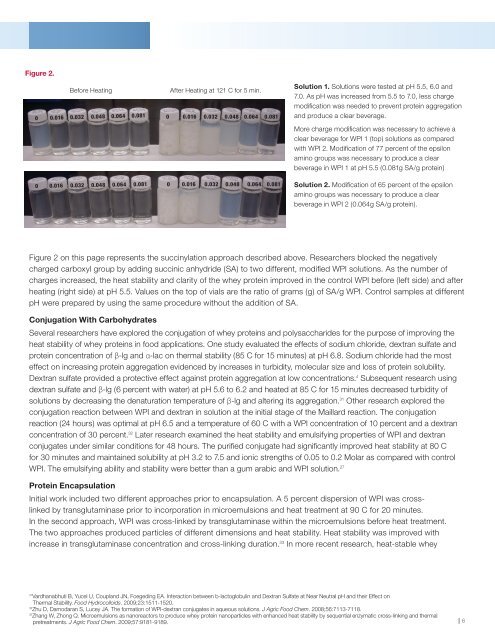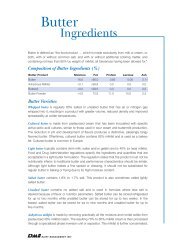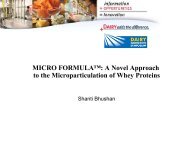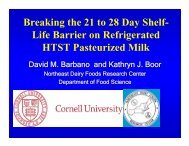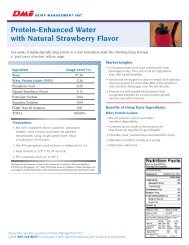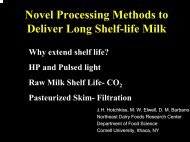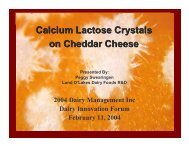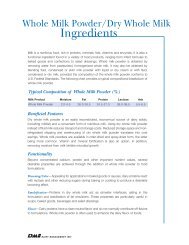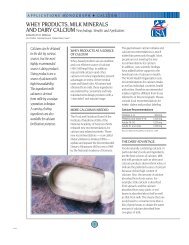Whey Protein Characteristics - InnovateWithDairy.com
Whey Protein Characteristics - InnovateWithDairy.com
Whey Protein Characteristics - InnovateWithDairy.com
Create successful ePaper yourself
Turn your PDF publications into a flip-book with our unique Google optimized e-Paper software.
Technical Report:<br />
<strong>Whey</strong> <strong>Protein</strong> Heat Stability<br />
Figure 2.<br />
Before Heating<br />
After Heating at 121 C for 5 min.<br />
0 0.016 0.032 0.048 0.064 0.081 0 0.016 0.032 0.048 0.064 0.081<br />
Solution 1. Solutions were tested at pH 5.5, 6.0 and<br />
7.0. As pH was increased from 5.5 to 7.0, less charge<br />
modification was needed to prevent protein aggregation<br />
and produce a clear beverage.<br />
More charge modification was necessary to achieve a<br />
clear beverage for WPI 1 (top) solutions as <strong>com</strong>pared<br />
with WPI 2. Modification of 77 percent of the epsilon<br />
amino groups was necessary to produce a clear<br />
beverage in WPI 1 at pH 5.5 (0.081g SA/g protein)<br />
0 0.016 0.032 0.048 0.064 0.081 0 0.016 0.032 0.048 0.064 0.081<br />
Solution 2. Modification of 65 percent of the epsilon<br />
amino groups was necessary to produce a clear<br />
beverage in WPI 2 (0.064g SA/g protein).<br />
Figure 2 on this page represents the succinylation approach described above. Researchers blocked the negatively<br />
charged carboxyl group by adding succinic anhydride (SA) to two different, modified WPI solutions. As the number of<br />
charges increased, the heat stability and clarity of the whey protein improved in the control WPI before (left side) and after<br />
heating (right side) at pH 5.5. Values on the top of vials are the ratio of grams (g) of SA/g WPI. Control samples at different<br />
pH were prepared by using the same procedure without the addition of SA.<br />
Conjugation With Carbohydrates<br />
Several researchers have explored the conjugation of whey proteins and polysaccharides for the purpose of improving the<br />
heat stability of whey proteins in food applications. One study evaluated the effects of sodium chloride, dextran sulfate and<br />
protein concentration of β-lg and α-lac on thermal stability (85 C for 15 minutes) at pH 6.8. Sodium chloride had the most<br />
effect on increasing protein aggregation evidenced by increases in turbidity, molecular size and loss of protein solubility.<br />
Dextran sulfate provided a protective effect against protein aggregation at low concentrations. 4 Subsequent research using<br />
dextran sulfate and β-lg (6 percent with water) at pH 5.6 to 6.2 and heated at 85 C for 15 minutes decreased turbidity of<br />
solutions by decreasing the denaturation temperature of β-lg and altering its aggregation. 31 Other research explored the<br />
conjugation reaction between WPI and dextran in solution at the initial stage of the Maillard reaction. The conjugation<br />
reaction (24 hours) was optimal at pH 6.5 and a temperature of 60 C with a WPI concentration of 10 percent and a dextran<br />
concentration of 30 percent. 32 Later research examined the heat stability and emulsifying properties of WPI and dextran<br />
conjugates under similar conditions for 48 hours. The purified conjugate had significantly improved heat stability at 80 C<br />
for 30 minutes and maintained solubility at pH 3.2 to 7.5 and ionic strengths of 0.05 to 0.2 Molar as <strong>com</strong>pared with control<br />
WPI. The emulsifying ability and stability were better than a gum arabic and WPI solution. 27<br />
<strong>Protein</strong> Encapsulation<br />
Initial work included two different approaches prior to encapsulation. A 5 percent dispersion of WPI was crosslinked<br />
by transglutaminase prior to incorporation in microemulsions and heat treatment at 90 C for 20 minutes.<br />
In the second approach, WPI was cross-linked by transglutaminase within the microemulsions before heat treatment.<br />
The two approaches produced particles of different dimensions and heat stability. Heat stability was improved with<br />
increase in transglutaminase concentration and cross-linking duration. 33 In more recent research, heat-stable whey<br />
31<br />
Vardhanabhuti B, Yucel U, Coupland JN, Foegeding EA. Interaction between b-lactoglobulin and Dextran Sulfate at Near Neutral pH and their Effect on<br />
Thermal Stability. Food Hydrocolloids. 2009;23:1511-1520.<br />
32<br />
Zhu D, Damodaran S, Lucey JA. The formation of WPI-dextran conjugates in aqueous solutions. J Agric Food Chem. 2008;56:7113-7118.<br />
33<br />
Zhang W, Zhong Q. Microemulsions as nanoreactors to produce whey protein nanoparticles with enhanced heat stability by sequential enzymatic cross-linking and thermal<br />
pretreatments. J Agric Food Chem. 2009;57:9181-9189.<br />
e3..6


